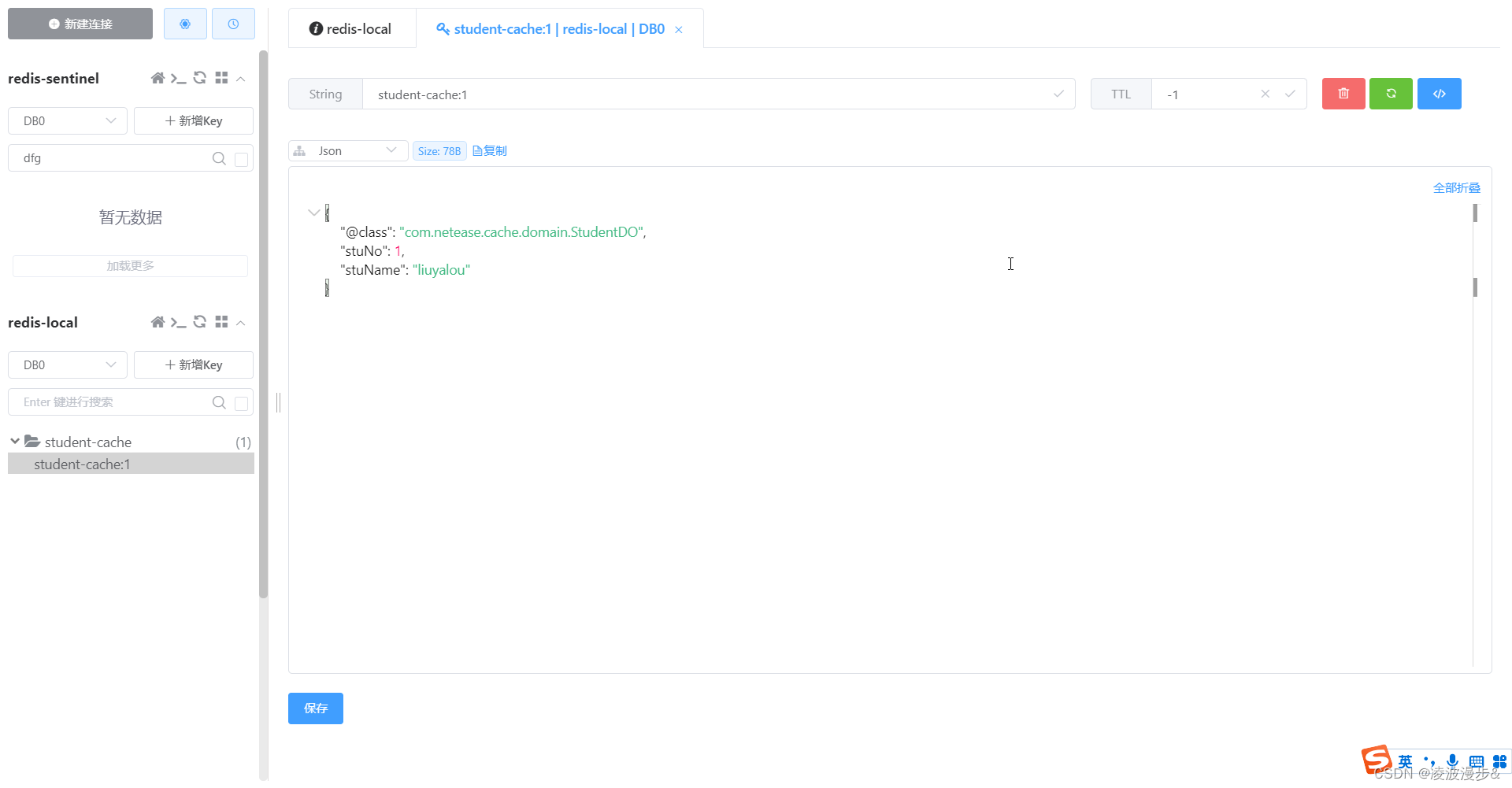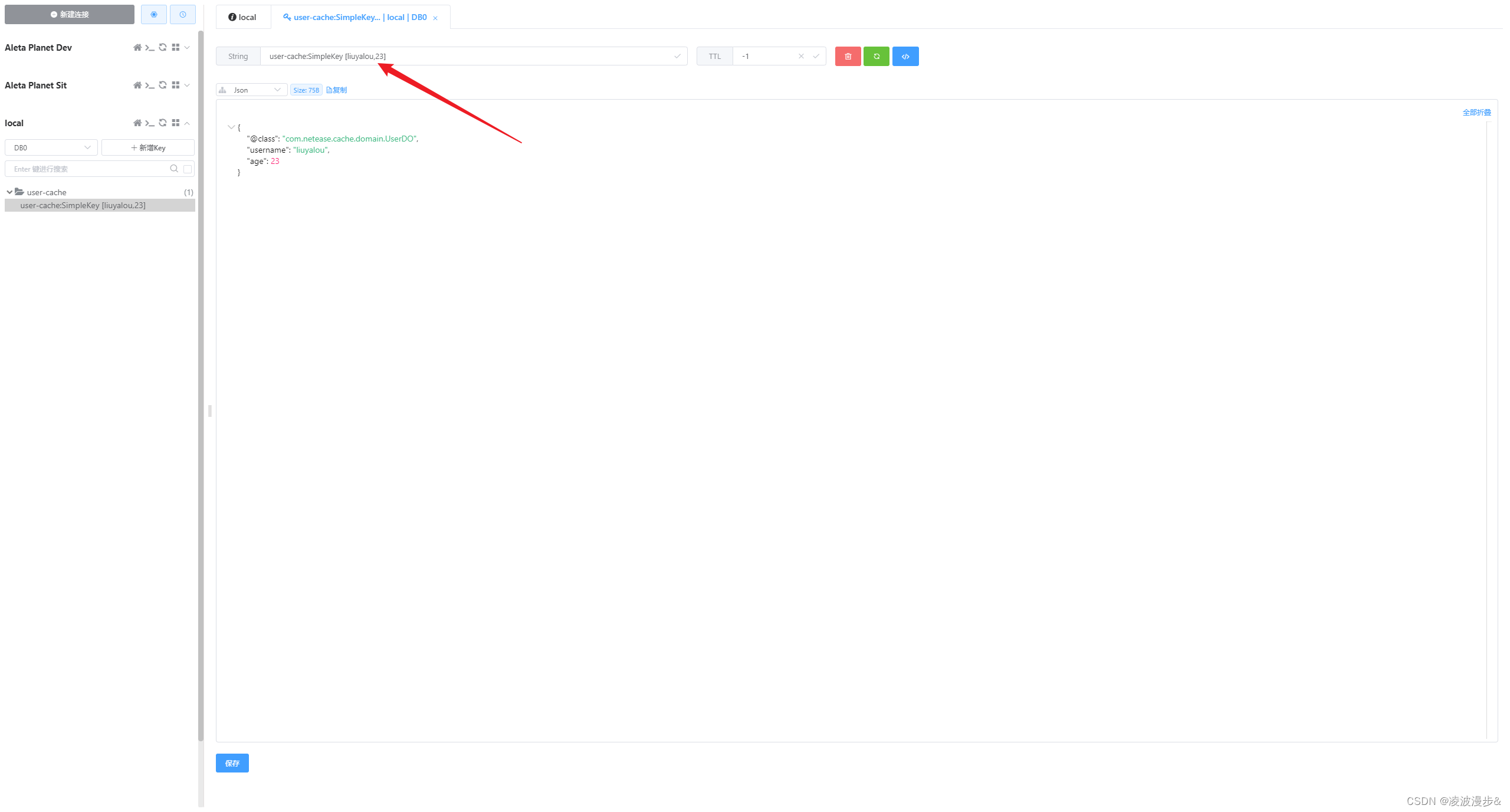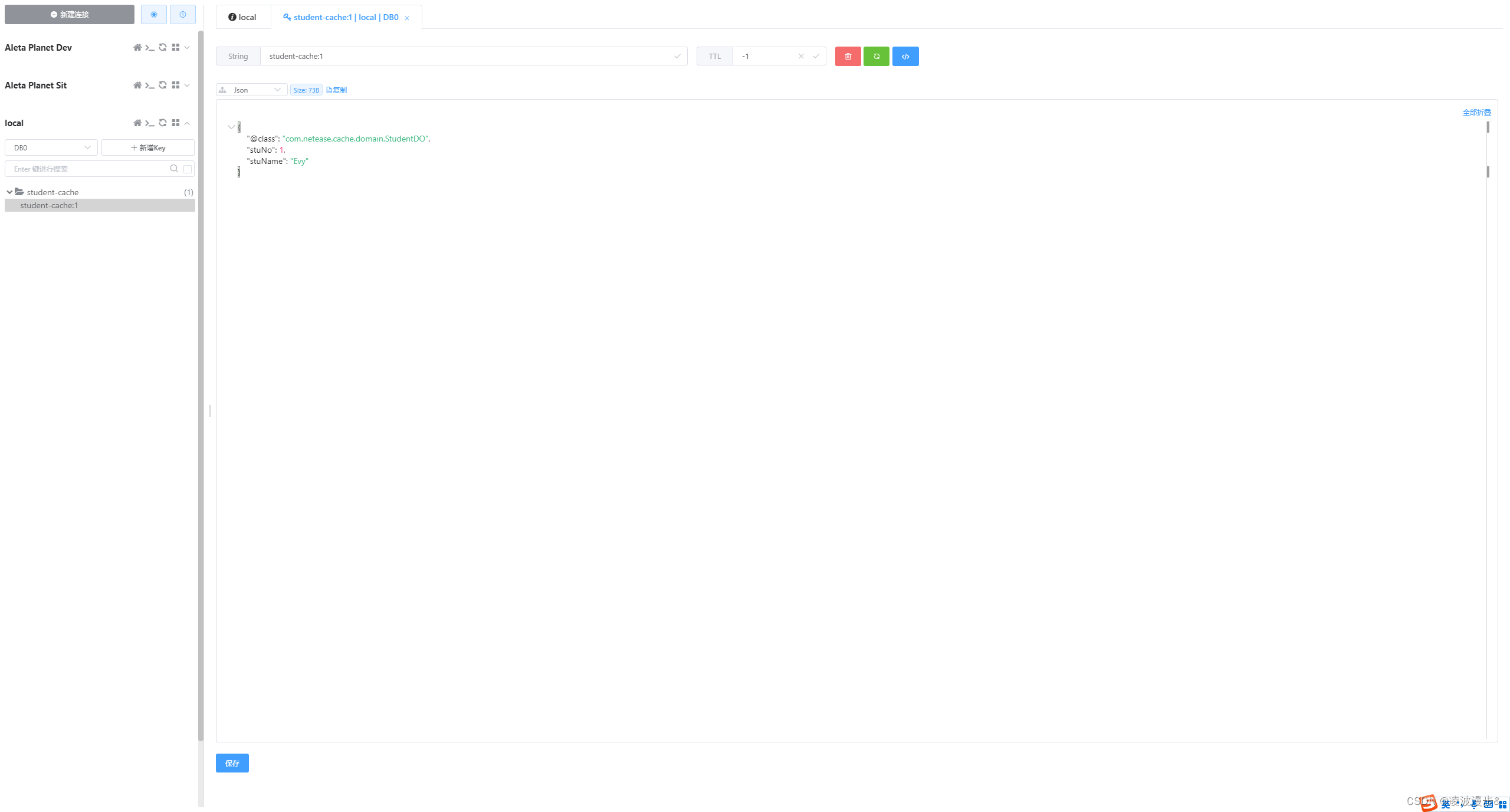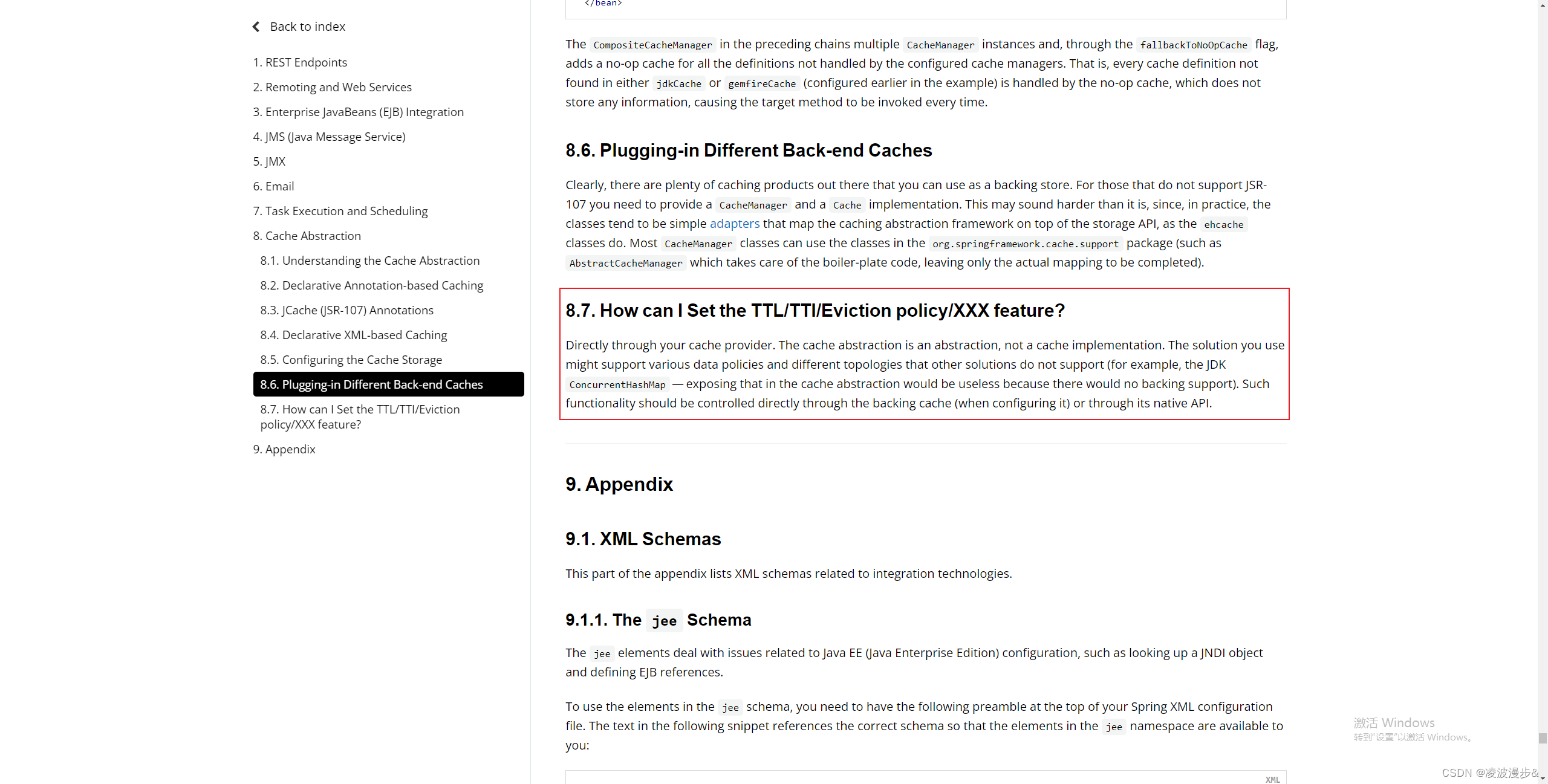目录
一、序言
在前面 Spring声明式基于注解的缓存(1-理论篇)一节中我们大致介绍了基于注解的缓存抽象相关理论知识,包括常用注解@Cacheable、@CachePut、@CacheEvict、@Caching和@CacheConfig,还有缓存相关组件CacheManager和CacheResolver的作用。
这篇是实战环节,主要会包含缓存相关注解的应用。
二、使用示例
1、配置
(1) application.properties
spring.redis.host=127.0.0.1
spring.redis.port=6379
spring.redis.password=lyl
spring.redis.database=0
spring.redis.timeout=1000ms
spring.redis.lettuce.pool.min-idle=0
spring.redis.lettuce.pool.max-idle=8
spring.redis.lettuce.pool.max-active=50
spring.redis.lettuce.pool.max-wait=1000ms
spring.redis.lettuce.pool.time-between-eviction-runs=30000ms
(2) 基于Redis缓存的CacheManager配置
@EnableCaching
@Configuration
public class RedisCacheConfig {
private static final String KEY_SEPERATOR = ":";
/**
* 自定义CacheManager,具体配置参考{@link org.springframework.boot.autoconfigure.cache.RedisCacheConfiguration}
* @param redisConnectionFactory 自动配置会注入
* @return
*/
@Bean(name = "redisCacheManager")
public RedisCacheManager redisCacheManager(RedisConnectionFactory redisConnectionFactory) {
RedisSerializer<String> keySerializer = new StringRedisSerializer();
RedisSerializer<Object> valueSerializer = new GenericJackson2JsonRedisSerializer();
RedisCacheConfiguration cacheConfig = RedisCacheConfiguration.defaultCacheConfig()
.serializeKeysWith(SerializationPair.fromSerializer(keySerializer))
.serializeValuesWith(SerializationPair.fromSerializer(valueSerializer))
.computePrefixWith(key -> key.concat(KEY_SEPERATOR));
return RedisCacheManager.builder(redisConnectionFactory).cacheDefaults(cacheConfig).build();
}
}
备注:上面我们指定了
key和value的序列化器,还有缓存key的拼接策略。
2、注解运用测试用例
SpringCacheService定义了相关的缓存操作,如下:
@Service
@CacheConfig(cacheManager = "redisCacheManager")
public class SpringCacheService {
/**
* key:缓存key名称,支持SPEL
* value:缓存名称
* condition:满足条件可缓存才缓存结果,支持SPEL
* unless:满足条件结果不缓存,支持SPEL
* @param stuNo
* @return
*/
@Cacheable(key = "#stuNo", value = "student-cache", condition = "#stuNo gt 0", unless = "#result eq null")
public StudentDO getStudentByNo(int stuNo) {
StudentDO student = new StudentDO(stuNo, "liuyalou");
System.out.println("模拟从数据库中读取:" + student);
return student;
}
/**
* 不指定key,默认会用{@link org.springframework.cache.interceptor.SimpleKeyGenerator}
* 如果方法无参数则返回空字符串,只有一个参数则返回参数值,两个参数则返回包含两参数的SimpleKey
* @param username
* @param age
* @return
*/
@Cacheable(value = "user-cache", unless = "#result eq null")
public UserDO getUserByUsernameAndAge(String username, int age) {
UserDO userDo = new UserDO(username, age);
System.out.println("模拟从数据库中读取:" + userDo);
return userDo;
}
@Cacheable(key = "#stuNo + '_' +#stuName", value = "student-cache", unless = "#result?.stuName eq null")
public Optional<StudentDO> getStudentByNoAndName(int stuNo, String stuName) {
if (stuNo <= 0) {
return Optional.empty();
}
StudentDO student = new StudentDO(stuNo, stuName);
System.out.println("模拟从数据库中读取:" + student);
return Optional.ofNullable(student);
}
@CacheEvict(value = "student-cache", key = "#stuNo")
public void removeStudentByStudNo(int stuNo) {
System.out.println("从数据库删除数据,key为" + stuNo + "的缓存将会被删");
}
@CachePut(value = "student-cache", key = "#student.stuNo", condition = "#result ne null")
public StudentDO updateStudent(StudentDO student) {
System.out.println("数据库进行了更新,检查缓存是否一致");
return student;
}
}
(1) 指定key条件式缓存
这里我们定义了名为student-cache,key为1的缓存,以及是否缓存的两个条件:
- 如果
stuNo小于0则不缓存。 - 如果方法执行结果不为空才缓存。
/**
* key:缓存key名称,支持SPEL
* value:缓存名称
* condition:满足条件可缓存才缓存结果,支持SPEL
* unless:满足条件结果不缓存,支持SPEL
* @param stuNo
* @return
*/
@Cacheable(key = "#stuNo", value = "student-cache", condition = "#stuNo gt 0", unless = "#result eq null")
public StudentDO getStudentByNo(int stuNo) {
StudentDO student = new StudentDO(stuNo, "liuyalou");
System.out.println("模拟从数据库中读取:" + student);
return student;
}
@Test
public void getStudentByNo() {
StudentDO studentDo = springCacheService.getStudentByNo(1);
System.out.println(studentDo);
}
控制台输出如下,如果Redis中没有该student-cache:1对应的值,则会执行方法体的代码。
模拟从数据库中读取:StudentDO[stuName=liuyalou,stuNo=1]
程序执行结果为: StudentDO[stuName=liuyalou,stuNo=1]
该方法执行后,让我们看看Redis中的key,可以看到多了student-cache:1的缓存键值对信息。

备注:当再次执行该方法时,不会执行方法体逻辑,而是从Redis中获取对应缓存key的值。
(2) 返回值为Optional类型条件式缓存
这里我们自定义了名为student-cache,key为stuNo_stuName的缓存,方法返回参数为Optional类型。如果Optional的值为空,则方法的执行结果不会被缓存。
@Cacheable(key = "#stuNo + '_' +#stuName", value = "student-cache", unless = "#result?.stuName eq null")
public Optional<StudentDO> getStudentByNoAndName(int stuNo, String stuName) {
if (stuNo <= 0) {
return Optional.empty();
}
StudentDO student = new StudentDO(stuNo, stuName);
System.out.println("模拟从数据库中读取:" + student);
return Optional.ofNullable(student);
}
@Test
public void getStudentByNoAndName() {
Optional<StudentDO> studentDo = springCacheService.getStudentByNoAndName(1, "Nick");
System.out.println("程序执行结果为: " + studentDo.orElse(null));
}
备注:
#result指向的不是Optional实例,而是Student实例,因为Optional中的值可能为null,这里我们用了安全导航操作符?。
控制台输出:
模拟从数据库中读取:StudentDO[stuName=Nick,stuNo=1]
程序执行结果为: StudentDO[stuName=Nick,stuNo=1]
让我们再看下Redis中的key情况:

(3) 不指定key条件式缓存
下面的方法我们没有指定key属性,key的生成会用默认的key生成器SimpleKeyGenerator来生成。
@Cacheable(value = "user-cache", unless = "#result eq null")
public UserDO getUserByUsernameAndAge(String username, int age) {
UserDO userDo = new UserDO(username, age);
System.out.println("模拟从数据库中读取:" + userDo);
return userDo;
}
@Test
public void getUserByUsernameAndAge() {
UserDO userDo = springCacheService.getUserByUsernameAndAge("liuyalou", 23);
System.out.println("程序执行结果为: " + userDo);
}
方法执行完后,让我们看看Redis中的key情况:

备注:可以看到
SimpleKeyGernerator生成的key名是根据对象属性来生成的。
(4) 指定key删除缓存
这个注解我们用来根据指定缓存key来清除缓存。
@CacheEvict(value = "student-cache", key = "#stuNo")
public void removeStudentByStudNo(int stuNo) {
System.out.println("从数据库删除数据,key为" + stuNo + "的缓存将会被删");
}
@Test
public void getStudentByNo() {
StudentDO studentDo = springCacheService.getStudentByNo(1);
System.out.println("程序执行结果为: " + studentDo);
}
@Test
public void removeStudentByStudNo() {
springCacheService.removeStudentByStudNo(1);
}
我们先执行getStudentByNo测试用例,再执行removeStudentByStudNo,控制台输出如下:
模拟从数据库中读取:StudentDO[stuName=liuyalou,stuNo=1]
程序执行结果为: StudentDO[stuName=liuyalou,stuNo=1]
从数据库删除数据,key为1的缓存将会被删
备注:执行完后可以看到Redis中的key会被删除。
(5) 指定key更新缓存
接下来我们根据指定key更新缓存,这里我们也指定了缓存条件,只有当缓存结果不为空时才缓存。
@CachePut(value = "student-cache", key = "#student.stuNo", unless = "#result eq null”)
public StudentDO updateStudent(StudentDO student) {
System.out.println("数据库进行了更新,检查缓存是否一致");
return student;
}
@Test
public void updateStudent() {
StudentDO oldStudent = springCacheService.getStudentByNo(1);
System.out.println("原缓存内容为:" + oldStudent);
springCacheService.updateStudent(new StudentDO(1, "Evy"));
StudentDO newStudent = springCacheService.getStudentByNo(1);
System.out.println("更新后缓存内容为:" + newStudent);
}
控制台输出为:
原缓存内容为:StudentDO[stuName=Evy,stuNo=1]
数据库进行了更新,检查缓存是否一致
更新后缓存内容为:StudentDO[stuName=Evy,stuNo=1]
最终Redis中的key信息如下:

三、结语
总得来说,声明式缓存抽象和声明式事务一样,使用起来都比较简单。更多的细节描述可以参考:Spring缓存抽象官方文档。
有同学可能会发现,Spring提供的这些注解不支持过期时间的设置,官方文档也有一些解释,如下:

官方提供的建议是通过缓存提供器来实现,其实就是我们可以通过自定义CacheManager来实现。缓存抽象只是一种逻辑抽象,而不是具体的缓存实现,具体怎么写缓存,缓存写到哪里应该由缓存管理器来实现。
下一节我们会通过自定义CacheResolver、RedisCacheManager、以及相关Cache注解来实现带过期时间的缓存实现。
